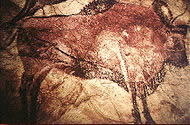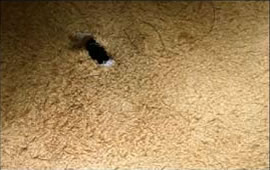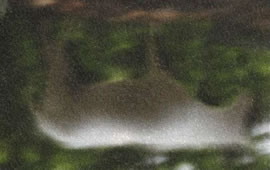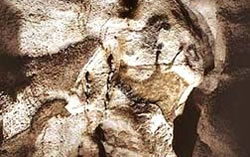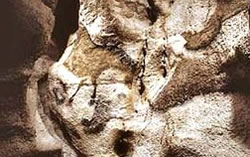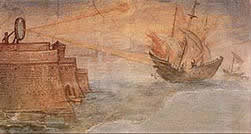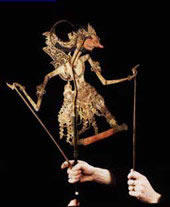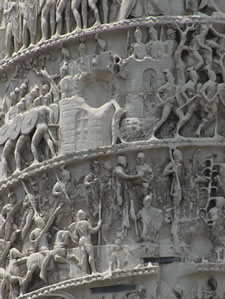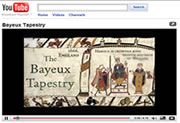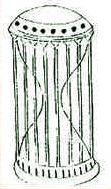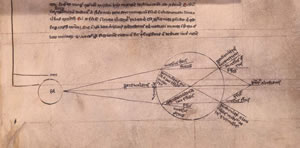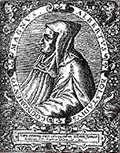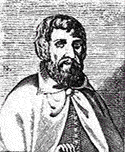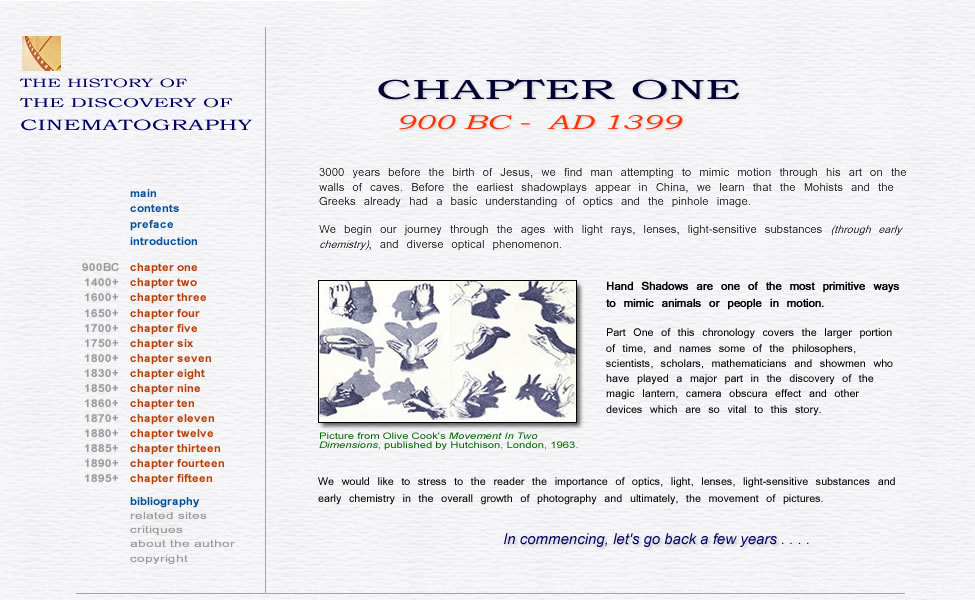
|
| |
|
|
|
| |
|
|
|
| |
In
the beginning God created the heaven and the earth. And the earth was
without form, and void; and darkness was upon the face of the deep. And
the Spirit of God moved upon the face of the waters. And God said, Let
there be light: and there was light. And God saw the light, that it
was good: and God divided the light from the darkness. |
|
| |
The
Holy Scriptures, Genesis, Chapter 1, verses 1 - 4, King James Bible |
|
| |
|
|
| |
|
|
| |
|
|
| |
|
|
| |
|
|
| |
ANTIQUITY
The forms of animals
in movement are discovered on the walls of caves throughout
the world. One of the world's most noted caves for this is
the Grotte de Lascaux in France. |
|
|
| |
|
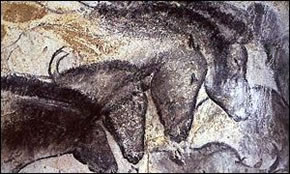 |
Motion has often been depicted in early cave art. When
the subject (mostly animals) has been that which can provide
movement, we often see it in that state. These two examples
show us the stationary bull or ox (above) , and
what appear to be four horses (left) perhaps in a
race.
The ox, which provides strength, food and clothing, is
motionless. However the horse, as a provider of transportation,
power and agility, is portrayed running.
This early
cave art (left) of four horses neck and neck in a
race, was discovered in the Chauvet Caves of France. |
|
| |
|
|
|
| |
|
|
|
| |
|
|
| |
|
|
|
| |
|
|
|
| |
 |
EIGHT-LEGGED BOAR
Not only was the portrayal
of motion the purpose for this rock painting of an eight-legged
boar, but it may also have been a very early attempt by the
artist to say that he doesn't understand why he is seeing
more legs than the animal has. Discovered at Altamira Spain,
the boar is clearly running in a blur with the artist 'seeing'
more legs than there are. There
is even a suggestion of two blurred heads as he thunders across
the plain.
Persistence of vision
and the blurring effect of after-images will not be understood
for several millennia.
|
|
|
| |
|
|
|
| |
|
|
|
| |
|
|
| |
|
|
|
| |
CAMERA OBSCURA
CAVES
Was the motion we
see depicted in early cave art a result of the actual motion
seen by the artist within the cave? Perhaps this is why the
subjects where always living creatures, and not still life
or landscapes.
The pectographs and pictographs
of horses, bulls, oxen and ibexes, mammoths, cats, rhinos,
stags, bison, bovine, and bears are the most often documented
art seen in caves. Even in Australian caves we see kangaroos.
Still life and landscapes are not seen, or at least are rare.
In speaking of the Altamira
cave paintings which are comprised mostly of bison, Matthew
S. Johnson writes "These pictures
are of the animals only and contain no landscape or horizontal
base."
|
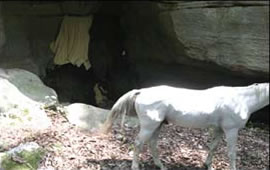
|
| |
|
Enclosed
cave using a hide covering |
MOVING
CAVE ART
Did these artists see
the animals outside their caves or tents, and then go inside
and paint from memory? Or did they actually see these animals
from within the caves, moving on an inside cave wall?
In his study of the
Altamira cave discovery, Jochen Duckeck writes "Basically,
the pictures are dynamic and the movement of the animals comes
to life through the thoughtful use of the reliefs and uneven
surface of the walls, thus creating a breathtaking effect."
If men did see animals
moving on the walls of their caves, this then may expalin why
they painted an upside-down horse on the wall of the Painted
Gallery at Lascaux, France.
Why would the artist paint an animal upside down on the wall?
Perhaps its because he saw an upside down horse on the wall.
It has been shown that the pinhole image can be seen in this
very environment. |
|
| |
|
Pinhole
in the hide covering the entrance |
It
is quite possible therefore that the camera obscura effect was
seen in primitive times and documented as well. Not with ink
on paper however, but with primitive paint on cave walls.
Matt Gatton presents one
such theory in his work, The Camera Obscura and the
Origin of Art: the Case for Image Projection in the Paleolithic.
The photographs to the right from Gatton's field research show
that camera obscura caves are more than a theory.
Afterall, is not the camera
obscura simply a dark room with a hole? If the pinhole image
can be seen through crossed wicker, crossed fingers, or the
leaves in trees, why not a hole in a hide covering used to seal
a cave entrance? |
|
| |
|
Image of the horse on the inside
cave wall in it's natural state - upside down
|
| |
|
|
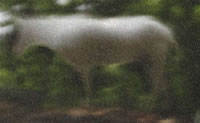 |
The
image to the left is the up-righted horse from Matt Gatton's
field work (three right images above) showing that
the camera obscura effect could very well have been seen by
early men who lived in caves or tents.
Is the camera
obscura effect the reason why we see a painted image of an upside
down horse in the Grotte de Lascaux in France? (see below) |
|
| |
|
|
| Matt
Gatton's field reconstruction work has given us the above three
images (right). The top-most image shows a rock overhang
and hide covering producing a small darkened 'cave'- like room;
in the centre photograph we see a hole in the hide covering; the
bottom image is the horse presented to the early cave dweller
on his living room wall. |
| |
|
|
| Gatton's
theory is based on a fundamental fact we already know to be true;
the pinhole image and the resulting camera obscura effect. In
reference to early humans who dwelt in caves or hide-covered tents,
Gatton states "Small random holes
in these hide tents would have coincidentally and occasionally
formed camera obscuras, projecting moving images inside the dwelling
spaces." |
| |
|
|
| That
the camera obscura effect is a well-known optical principal incorporating
a darkened space receiving the linearity of light rays through
a small hole, is a phenomenon which is undebatable. It is therefore
conceivable that early men saw 'movies' or cinematography, in
their own homes as we do today. To this end, Gatton goes on,
"Imagine, if you will, a Paleolithic person waking in
the morning to find the image of animals walking around on the
wall, the three-dimensional world reduced to two dimensions on
a surface inside the tent." |
| |
|
|
| If
the camera obscura effect was in fact seen by early cave dwellers,
this would pre-date the observances of Mo Ti and Aristotle by
at least several thousand years. |
| |
|
|
|
The
Up-Side Down Horse of Lascaux (left) and the
up-righted horse (right).
Theorists and historians suggest the horse being in
this unique position, was depicted as scratching its
back on the ground, playing, or had stumbled and was
up-righting itself after a chase.
Image
Source: Le Ministère de la Culture et de la Communication
/ The Cave Of Lascaux |
|
|
| |
|
|
| If
up-side down horses weren't enough, unicorns have also been seen
in cave art. |
|
|
|
|
| |
|
|
|
| |
|
|
| |
|
|
|
| |
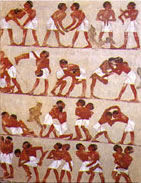 |
EGYPTIAN ART
Although frontality
tended to be emphasized through symmetry, leaving little opportunity
for movement in the Old Kingdom, the Middle and New Kingdoms
saw an emergence of boldness, drive, and inspiration in Egyptian
art.
This Egyptian painting
(left) shows an example of Middle to New Kingdom
vitality in its attempt to portray wrestlers in succesive
phases of movement during a practice session or bout. Each
pane illustrates the wrestlers grappling for position as if
in individual cels.
Modern animation has additional
roots in this form of artwork as much as in the spiral friezes
of ancient Rome, the Bayeaux Tapestry or any of the Oriental
Scrolls of China and Japan. Just like the frames of today
never actually move, so do these strips remain motionless,
yet are full of movement in the final outcome. Cut these sections
into a flipbook and we may just have something.
|
|
|
| |
|
|
|
| |
|
|
| |
|
|
|
| |
|
|
|
| |
ca. 3000 B.C. |
|
|
| |
Egyptians and Babylonians
acknowledge light and shadow, and may have used them in primitive forms
of entertainment. The Chaldeans may have used magnifying glasses in conjunction
with studies in light. Lenses will be unearthed in the 19th century dating
back to this period. The Asian shadow play and Japanese mirrors make an
appearance. The Chinese will use firelight to illuminate their shadows. |
|
| |
|
|
|
| |
|
|
|
| |
|
|
| |
|
|
| |
 |
9TH CENTURY B.C.
Sir AUSTEN HENRY LAYARD (1817 - 1894)
An archaeologist,
Layard excavates the remains of Babylon in 1850 and describes
a rock-crystal find dating back to this period (the first
lenses).
Layard shook the
world a year earlier (1849) when he unearthed Nineveh.
A.H. Layard
(left) was 28 (1845) when he began his work
Image source: National Portrait Gallery, London (Drawing
by G.F. Watts)
|
|
|
| |
|
|
|
| |
|
|
| |
|
|
|
| |
|
|
|
| |
721
- 705 B.C.
LAYARD LENS
Layard discovered this lens (right) which is considered
the first used (or found) plano-convex lens. This lens however
was not "ground" and polished round but had facets which limited
it's ability to magnify. It has been said that this lens could
actually have been only an ornament or menagerie. The reproduction
shown here shows both a horizontal and straight view. |

Layard Lens
|
|
|
| |
|
|
|
| |
|
|
|
| |
ca. 600 B.C. |
|
|
| |
A quartz lens (convex)
is found in the ruins of Nineveh dating to this period. |
|
| |
|
|
|
| |
|
|
|
| |
SOPHOCLES (ca. 495[6] - 406 B.C.) |
|
|
| |
This great, tragic playwright
of classical Greece writes in poetic form the need to keep a "light
sensitive substance in a dark room", in his poem 'Trachinierinnen'
(History of Photography, J.M. Eder, Columbia Univ. Press, NY, 1945, p4). |
|
| |
|
|
|
| |
|
|
| |
|
|
| |
HERODOTUS
(484 - 425 B.C.)
Accepts
the teaching that "the black emanations
of the body" are why the Ethiopian has his colour.
|
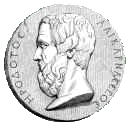 Herodotus 484 - 425 BC
Herodotus 484 - 425 BC |
|
|
| |
|
|
| |
|
|
| |
|
|
|
| |
4TH CENTURY B.C.
ARCHYTAS OF TARENTUM |
|
|
| |
It is documented that
this philosopher made some sort of bird made of wood, which apparently
'moved' in the air through the use of air pressure, and counterweights.
An early form of automaton it would appear. |
|
| |
|
|
|
| |
|
|
|
| |
|
|
| |
|
|
|
| |
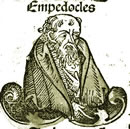 |
EMPEDOCLES
(483 - 424 B.C.)
This self-styled god,
poet and statesman said that light was matter, or "corpuscles",
and that it emanates from all bodies, reaching the eye. He later
flung himself into Mount Etna to convince people of his divinity.
|
|
|
| |
|
|
|
| |
|
|
| |
|
|
|
|
|
|
|
| |
MO TI (470 - 391 ) B.C. |
|
|
| |
Also known as MOZU, MOTZE,
MOTSE, MICIUS and MO-TZU. No further research to date, pre-dates (5th
Century B.C.) the Chinese with the documented observance of an
inverted image through a pinhole onto a screen. Mohists knew and taught
the linearity of light rays. They knew that light travels in straight
lines as did the Greeks at or around the same time. Philosophers Mo Ti
and Chuang Chou (c.369-286 B.C.) commented on the property of shadows.
Mo Ti recorded the observation of an inverted image through a pinhole
and talks of the "collecting place"
(aperture). He also explains why the image is inverted and uses
the analogy of the oar in the rowlock. Mohists knew and taught that objects
reflect light and called it "shinning forth". |
|
| |
|
|
|
| |
|
|
|
| |
|
|
| |
|
|
|
| |
PLATO
(428 - 347) B.C.
This
Greek philosopher writes that rays of light are emitted from the
eyes, and that objects receive these rays. He also philosophizes
about shadows on cave walls. In 'The Republic'
(360BC), Plato provides for us his concept of the visible world
in two separate states; one containing the physical and all that
is created, the other being the imagined state as in reflections
and shadows. |
 Plato 428 - 347 BC
Plato 428 - 347 BC |
|
|
|
|
|
|
| |
|
|
| |
|
|
| |
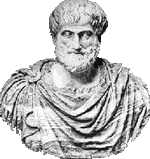 Aristotle 384 - 322 BC
Aristotle 384 - 322 BC |
ARISTOTLE
(384 - 322) B.C.
This
Greek philosopher taught that objects themselves emit light which
the eye sees. Aristotle observes crescent-shaped images created
during an eclipse, through small holes in the leaves of trees, furniture
and the crossing of the fingers. Aristotle notes that the smaller
the hole, the clearer the image. He goes on to observe that regardless
of the shape of the pinhole (aperture), the light passing through
is always in a circular shape. In his essay entitled 'On
The Form Of The Eclipse', Aristotle wrote;
"The
image of the sun at the time of the eclipse, unless it is total,
demonstrates that when its light passes through a narrow, round
hole and is cast on a plane opposite to the hole it takes on the
form of a moon-sickle. The image of the sun shows this peculiarity
only when the hole is very small. When the hole is enlarged, the
picture changes . . . ." |
| This
phenomenon will become known as one of Aristotle's "problems" (Aristotle,
A Treatise Called Problems, On Dreams) and will remain
unreasoned until the 16th century. Aristotle also referred to the
persistence of vision when mentioning after-images. |
| |
As did
Holmes, Marey and Muybridge some twenty-two centuries later, Aristotle
also contemplates the gait of both animals and humans in a short
text he wrote entitled  In his work he states “If a man
were to walk parallel to a wall in sunshine, the line described
(by the shadow of his head) would be not straight but zigzag...”.
This discussion by Aristotle incorporates the theories of light
and shadow, and how they interact. Aristotle said
"Nature does nothing uselessly. Nature
does nothing in vain".
In his work he states “If a man
were to walk parallel to a wall in sunshine, the line described
(by the shadow of his head) would be not straight but zigzag...”.
This discussion by Aristotle incorporates the theories of light
and shadow, and how they interact. Aristotle said
"Nature does nothing uselessly. Nature
does nothing in vain". |
|
|
| |
|
|
| |
|
|
| |
|
|
|
| |
|
|
|
| |
DEMOCRITUS (ca. 460 - 370) B.C. |
|
|
| |
Democritus accepted and
agreed with the teachings of Aristotle. Aristotle's theory that objects
emit light was the closest to the truth (that objects reflect the light
that strikes them). Democritus, a Greek philosopher, spoke on colours.
He said white objects are made of flat, smooth atoms which cast no shadows.
He also said dark objects are made of rough uneven atoms which cast shadows.
An incorrect, although interesting thought. |
|
| |
|
|
|
| |
|
|
|
| |
|
|
| |
|
|
|
| |
EUCLID
(EUCLEIDES) (fl.ca. 325 - 265) B.C.
This
philosopher and outstanding mathematician of his day also agreed
with what Aristotle taught. Euclid further studied in optics and
taught that each eye perceives a different image and that these
two images are "fused" to form the
"whole". Euclid talks of the linearity of light and writes
his The Optics of which two extant copies exist
(Euclid's own treatise and a revision by Theon). Subjects
included optics of mirrors, including both flat and spherical mirrors.
|
 Euclid of Alexandria 325 - 265
BC
Euclid of Alexandria 325 - 265
BC |
|
|
| |
|
|
|
| |
|
|
| |
|
|
| |
| |
ARCHIMEDES
(ca. 287 - 212) B.C.
This
Greek mathematician and geometrician considered using burning
glasses in warfare to defend the Sicilian colony of Syracuse.
His theory was to burn the ships of the enemy by magnifying the
sun's rays using the burning glass effect. In the 17th century,
Kircher will travel to Syracuse to study the possibility that
Archimedes actually carried out the strategy. He provided for
us a marvelous illustration depicting the event in his 'Ars
Magna' of 1646. Robertson as well, in 1796 will propose
to the French government his ‚€˜Miroir d'Archimede‚€™
or Mirrors of Archimedes, and a plan for burning
the invading ships of the English navy. The plan was refused.
|
Archimedes'
Burning Glass Warfare
Painting from the Stanzino delle Matematiche in the Galleria degli
Uffizi (Florence, Italy). Painted by Giulio Parigi (1571-1635)
in 1599.
Galleria degli Uffizi. |
|
|
| |
|
|
| |
"When Marcellus
withdrew them [his ships] a bow-shot, the old man [Archimedes] constructed
a kind of hexagonal mirror, and at an interval proportionate to the size
of the mirror he set similar small mirrors with four edges, moved by links
and by a form of hinge, and made it the centre of the sun's beams--its
noon-tide beam, whether in summer or in mid-winter. Afterwards, when the
beams were reflected in the mirror, a fearful kindling of fire was raised
in the ships, and at the distance of a bow-shot he turned them into ashes.
In this way did the old man prevail over Marcellus with his weapons". |
|
| |
- GREEK MATHEMATICAL
WORKS, Translated by Ivor Thomas, Cambridge, 1941, Volume II,
Page 19 Loeb Classical
Library, Harvard University Press |
|
| |
|
|
| |
|
|
| |
|
|
|
| |
| |
SHAO ONG
(ca. 121 ) B.C.
Documented in the
'Shih Chi' and 'Chhien Han Shu' of the
Han period (ch.28, p24) [Trans., Chavannes, vol.3, p470]
is the shadow play by the magician called Shao
Ong who made the spirit (it would appear) of a dead concubine
appear to the Emperor Wu Ti. This sort of shadowful illusion was
repeated many times throughout Chinese culture and all of Asia.
These puppets were made of paper-thin cutouts and were called
Shadowplays, and later known as Shades.
Also heaped in Chinese culture are the many instances documented
where images of landscapes are seen upon frozen surfaces. Rivers,
lakes and basins have numerous times been reported to "hold" the
scenes of nature.
Shadowplays, or Shades
as they were known, came in all shapes and sizes. Although shadows
were cast upon walls or behind thin screens, some puppets were
actually meant for direct viewing, as this (left) one indicates.
Usually made from dried animal skins or primitive paper and then
painted, Shades were found in many cultures including China, Turkey
and Greece. |
|
|
| |
|
|
|
| |
|
|
| |
|
|
|
| |
|
|
|
| |
VITRUVIUS ( ca. 80-70 B.C. - ca.
25 B.C.) |
|
|
| |
Officially known as Marcus
Vitruvius Pollio, he reports in his work on the metal "minium" (red lead)
'De Architectura' (vii.9) "it spoils
immediately when exposed to their rays and the colour looses its vividness
and brilliancy, turning black."
SEE PLINY, below. |
|
| |
|
|
|
| |
|
|
|
| |
60 B.C.
LUCRETIUS (TITUS LUCRETIUS CARUS) (98 - 55 B.C.) |
|
|
| |
This Roman poet and naturalist
combines science and poetry in his 'De Rerum Natura' (On
The Nature Of Things, T. L. Carus, IV, 768ff) when he refers to some
sort of projection show or dream image in poetic form. Perhaps a shadow
play or something similar to that of Plato. It has been suggested that
this work has been incorrectly interpreted. |
|
| |
|
|
|
|
|
|
|
| |
PABLIUS PAPINIUS STATIUS (A.D. 40
- 96) |
|
|
| |
This poet laureate of
Rome writes in his poem 'The Hair of Earinus' (silvae,
iii.4, capilli flavi earini) "....do
you only fix your glance upon it and leave your features here. Thus he
spoke and showed the mirror with the image caught therein."
In 1928, the Frankfurter Nachrichten reported on the poem's translation,
"his image was permanently fixed on a small silver
plate, [the original poem speaks of gold]
into which he had gazed for a period of time." |
|
| |
|
|
|
|
|
|
|
| |
PLINY (THE ELDER) (A.D. 23 - 79) |
|
|
| |
Pliny refers to silver
chloride and it's potential to darken under sun or moon in his 'Historiae
Naturalis' (xxxiii. 55,3) when he says "silver
changes it's colour in mineral water as well as by salt air, as, for instance
on the Mediterranean shores of Spain", and (xxxiii.40)
"the effect of the sun and moon on a coat of
minium is injurious." Eder, in his book 'History of
Photography' (pp2,7) dispels this as doubtful and suggests
hydrogen sulphide as the chemical. |
|
| |
|
|
|
| |
|
|
|
| |
LUCIUS ANNAEUS SENECA
(THE YOUNGER) (ca. 4 B.C. - A.D. 65) |
|
| |
Around 50 A.D. Seneca
writes on persistence of vision and says that rock-crystal lenses where
used as burning glasses. He described the magnification of objects seen
in water and wrote, "Letters, however small and
indistinct, are seen enlarged and more clearly through a globe of glass
filled with water." |
|
| |
|
|
|
| |
|
|
|
| |
A.D. 79 |
|
|
| |
Excavations at Pompeii
and Herculaneum reveal a lens. |
|
| |
|
|
|
| |
|
|
|
| |
|
|
|
|
|
|
| |
A.D. 113
MARCUS ULPIUS TRAIANUS (A.D. 53 - ) TRAJANS COLUMN |
|
| |
In A.D. 113 the Roman
Senate as initiated by Emperor Trajan, commissioned the construction of
an honourary column to be named after Trajan himself, and his victories
in the wars over Dacia (modern day Romania) from 101 until 106. This freestanding
triumphant military column had three sections which included; a massive
rectangular base depicting the spoils of war in deep base relief; a one
hundred foot high main shaft; and a domed pedestal which originally housed
a statue of an eagle. |
|
| |
|
|
|
| |
What
makes the Column of Trajan a spectacular entry in the history
of cinematography is the magnificent story-telling imagination
of these ancients. The memorial appears as if a strip of celluloid
has been wrapped around the column.
When we look closer at the
column, we see the unique history of two complete conquering
wars seen through a spiral frieze 625 feet in length. As if
one of the Roman soldiers had taken a film of the Dacian Wars,
processed it, and then wrapped it from bottom to top, this base
relief monument tells the story of victory frame-by-frame, scene-by-scene.
The spiral frieze winds its
way around the column with individual 'scenes' showcasing Trajan's
armies in battle. The bottom width of the column begins with
an amazing 60cm/2ft then doubles by the time it reaches the
top (120cm/4ft). More than 2000 carved figures adorn the frieze,
which tells the story of Trajan's Dacian wars between A.D.101-102
and A.D.105-106. The beginning scenes (bottom of the frieze)
show soldiers preparing for the war and ends with the conquering
of the Dacians. |
|
|
|
|
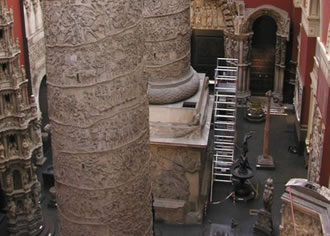
|
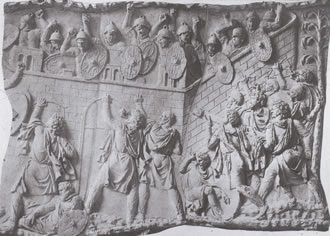
|
|
|
| |
LEFT IMAGE:
This is a plaster cast reproduction of the column of Trajan housed at
the Victoria & Albert Museum, London. The entire column being too
high is halved, with the upper half shown in the foreground and the lower
half sitting on its base, seen in the background. The individual scenes
can be seen as they unravel upwards. |
|
| |
CENTRE IMAGE:
Close-up of a section of the frieze identifying Dacian warriors attacking
a Roman fortress. |
|
| |
RIGHT IMAGE:
Trajans Column in its entirety. The main shaft consists of 20 individual
drums of carrara marble each weighing 40 tons. The drums sit on each other
creating the frieze which is 625 feet in height. Each drum is 13 feet
in diameter. The frieze winds around the shaft 23 times from bottom to
top. |
|
| |
|
|
| |
Portraying
Trajan's two successful campaigns against Dacia, the spiral is read or
"seen" as two separate halves; the lower half beginning at the
base illustrates the first wars (bewteen A.D. 101 and 102), and the upper
half illustrating the latter wars (between A.D. 105 and 106). The scenes
on the frieze unfold upwards as if in a strip of film. The scenes show
the Roman army within military activities; preparing for battle; engagement
of battle; construction; speeches by the emperor, and more. The carvings
within the scenes are filled with soldiers, senators, statesmen, priests
and sailors.
Over 2,500 Romans and Dacians appear in the frieze with Trajan himself
appearing over 50 times. |
|
| |
|
|
| |
Trajan's
Column can be found in Trajan's Forum which is part of the Imperial Forums
located at Via dei Fori Imperiali, right next to the Piazza Venezia in
Rome. A second Roman spiral frieze was completed in A.D. 193. SEE
MARCUS AURELIUS |
|
| |
|
|
|
|
|
|
|
| |
|
|
| |
|
|
| |
| 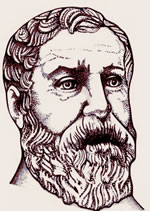
|
A.D. 120
HERON (62 - 125)
Heron of Alexandria
(also known as HERO) describes in 'Peri Automatopoietkes'
(Constructing Automaton Theatres) "phantom
mirrors" and "mirror writing."
Hero also writes
in his 'De Speculis' (the oldest extant
Greek writing on mirrors) about concave, convex and plane
mirrors. His 'Caoptrica' explains the rectilinear
propagation of light and the law of reflection.
Hero recorded the
description of a bird that sings which utilized a method of
hydraulic force. In 1620 Salomon de Caus, a French engineer,
will build a replica of this bird. (SEE
DE CAUS)
Heron of Alexandria
|
|
|
| |
|
|
|
| |
|
|
| |
|
|
| |
A.D.
150
CLAUDIUS PTOLEMAEUS (A.D. 85 - 165)
Ptolemy accepts Aristotle's
view that objects emit light. Ptolemy also writes his 'Almagest'
on optics and the universe and speaks of refraction,
reflection, persistence of vision and "stereoscopic
projection."
Ptolemy also developed
his theory on atmospheric refraction in another work, 'Optics'.
The book is translated into Latin in the 12th century by Admiral
Eugenius Siculus.
|
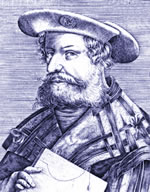 Ptolemy
85 - 165 AD
Ptolemy
85 - 165 AD |
|
|
| |
|
|
| |
|
|
| |
|
|
|
| |
TING HUAN (ca. A.D. 180) |
|
|
| |
The ascending convection
of hot air from a lamp caused animals and creatures to appear to move
naturally in his 'Pipe Which Makes Fantasies Appear."
This is perhaps the first account of the marriage of both illumination
and movement, created by the same source (lamp). |
|
| |
|
|
|
| |
|
|
|
|
|
|
| |
|
|
|
| |
A.D.
193
MARCUS AURELIUS (A.D. - 180) COLUMN OF MARCUS AURELIUS
Aurelius was Emperor of
Rome between A.D.161 and 180.
Modeled after Trajan's
Column, this spriral frieze is also 100 feet high, and commemorates
the wars over the Marcomanni and Quadi in Czechia, and the Sarmatians
in Hungary in A.D. 175.
The battles over the Marcomanni
and Quadi armies in the years 172 and 173 are represented in the
first half of the frieze, (the lower half of the column beginning
at the bottom spiraling upwards) and the victory over the Sarmatians
in the years 174 and 175 are depicted in the upper section (again,
spiraling upwards from approx. midway).
Aurelius was known as the "philosopher
emperor".
For a large, high-resolution
detailed image of this magnificent base relief column, click
here.
|
|
|
|
| |
|
Detail of the spiral
frieze of the column of Marcus Aurelius (above)
|
|
| |
|
|
|
| |
|
|
| |
|
|
|
| |
|
|
|
| |
ca. A.D. 170 - 200
GALEN (A.D. 129 - 199) |
|
|
| |
This Greek physicist and
physician studied binocular vision. |
|
| |
|
|
|
| |
|
|
| |
|
|
| |
| |
A.D. 510
BOETHIUS (A.D. 475 - 524)
Boethius
was a Roman scholar and mathematician and attempts to document
the speed of light. In 525 King Theodoric orders him decapitated
for treason and magic.
Anicus
Manlius Severinus Boethius |
|
|
| |
|
|
| |
|
|
| |
|
|
|
| |
|
|
|
| |
A.D. 750
GEBER (GABIR, DSCHABIR IBN HAJJAM) (A.D. 721 - 815) |
|
|
| |
This Arabian alchemist
observes the effect of light on silver nitrate. |
|
| |
|
|
|
| |
|
|
|
| |
8TH CENTURY |
|
|
| |
Both the Chinese and Arabs
continue to observe eclipses using the camera obscura effect. |
|
| |
|
|
|
| |
|
|
|
| |
10Th CENTURY
YU CHAO LUNG ( - ) |
|
|
| |
Builds miniature pagodas
to observe the pinhole images through a hole onto a screen and therefore
learns of the divergence of light rays using the camera obscura effect. |
|
| |
|
|
|
| |
|
|
|
| |
ca. A.D. 930
SUN KUANG-HSIEN |
|
|
| |
This traveler and writer
describes in his 'Dreams Of The North And Trifling Talk',
similar shadowplays to that of magician Shao Ong. |
|
| |
|
|
|
| |
|
|
| |
|
|
|
| |
A.D. 960 - 1127
MONUMENTAL LANDSCAPE PAINTINGS
JAPANESE NARRATIVE SCROLLS and CHINESE LANDSCAPE SCROLLS
Landscape, Narrative
and Monumental Scrolls are an art form which have been practiced
for centuries, mostly in East Asia and concentrating in Japan
and China. There are two basic kinds which we see in the Japanese
Narrative Scroll and the Chinese Landscape
Scroll. Like we have seen in numerous descriptive
paintings throughout the world, these scrolls unite storytelling
with motion and bring into our minds a cinematic strip full
of life and visual movement.
In the same way the Bayeux
Tapestry told the story of William of Normandy in
this very century, so does the panoramic Chinese painted scroll
express movement in two dimensions. Robert Barker in the early
19th century put paintbrush to canvas in his Panoramas
of Edinburgh and London. During the Northern Song Dynasty
(960 - 1127), the royal artist to Emperor Qian Long, Zhang
Zeduan, is suggested to have lead four other artists of the
court to paint what has become known as "Upper
River During Qing Ming Festival" (below).
|
| |
|
|
This
(above) watercolour on silk is one, if not the,
longest landscape scroll in Chinese history. The image seen
above is one small section. Full landscape below. |
|
|
| This
"Upper River During Qing Ming Festival"
scroll depicts hundreds of people in it's full length. As if imagined
in the painter's eye from several hundred feet above the Bian
River, this majestic panorama of 11th century Chinese life is
read from left to right and provides us with scenes of nature
and the life of the people. It's a pre-cinematic story told along
the same historical timeline to that of film, but without the
celluloid. |
| |
|
|
|
| |
|
| Both
sides of the river are clearly visible for a long distance through
the capital of Bian Liang which is today the city of Kaifeng in
the province of Henan. Zeduan, being a student of realism, created
this panorama in minute detail. This painting has been shown to
have no less than 1,643 people, 20 boats or ships, over 30 diferent
structures and 208 animals. |
| |
|
|
Our first scene in "Upper River During Qing Ming
Festival" shows a burial in a graveyard and travels
down river through the countryside, along the banks through
busy commercial areas. It depicts the country as well as city
life with shopkeepers and merchants, sedans for the traveller,
carts being pulled by mules, goods, camels, places of worship,
homes, eating places, teahouses, selling stalls, boats and the
inviting landscape, all in full colour. And all amongst the
splendid backdrop of the Qing Ming Festival. The Qing Ming Festival
is a remembrance day for the dead, hence the opening graveyard
scene. Celebrated in the spring, the festival participants show
respect for their ancestors. They visit their ancestor's tombs,
offering food and praying.
Qing Ming means 'pure brightness'. The painting is also known
as 'Riverside Scene at Qing Ming' and is almost
five metres in length. It is a quarter of a metre in height.
"Upper River During Qing Ming Festival"
resides at the National Palace Museum in Taipei.
Pictorial scrolls such as the one to the right are more ornamental
to westerners than artistic. They typically are created with
accompanying calendars, and show traditional figures in the
outdoors while highlighting the wildlife. Mostly ink paintings
on lengths of paper or silk, hand scrolls as they are also known
are traditional forms of art in Chinese and Japanese culture.
Normally the length of the arm, they are read downward or left
to right.
In this scroll (right) we see three females feeding
their carp. |
|
| |
Modern Hand Scroll |
| |
|
|
|
| |
|
|
| |
|
|
|
| |
|
|
|
| |
1010
ALHAZEN (965 - 1038) |
|
|
| |
Also known as IBN AL HAITHAM,
ABU ALI ALHASAN IBN ALHASAN, IBNU-I-HAITAM, AL HUSEN or HASSAN IBN HASSAN,
this Arabian scholar writes on the observances of the camera obscura effect.
Particular attention is drawn to the image of the eclipse and the "sickle-like
shapes" in his 'On The Form Of The Eclipse' which
includes many descriptions and drawings. As Aristotle did, Alhazen refers
to the clarity of the image when the aperture is smaller. His writings
on observations are held in London at the India Office Library. |
|
| |
|
|
|
| |
|
|
| |
|
|
| |
|
|
| |
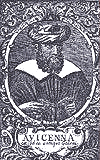 Avicenna
980 - 1037
Avicenna
980 - 1037 |
1020
AVICENNA (IBN SINA) (980 - 1037)
Avicena
suggested that light is emitted from the eyes and unites with
the luminous air. Avicenna stated “Now
it is established in the sciences that no knowledge is acquired
save through the study of its causes and beginnings, if it has
had causes and beginnings; nor completed except by knowledge of
its accidents and accompanying essentials”. |
|
|
| |
|
|
| |
|
|
| |
|
|
|
| |
1064 - 1066
THE BAYEUX TAPESTRY
Was the Bayeux
Tapestry an early attempt to describe an historical
event in cinematic fashion? Was it our first true epic told
in embroidered linen and wool instead of celluloid? Or was
the Tapestry simply art mirroring life by those who lived
it, just like a painting or a sculpture? Was Bishop Odo the
first director of a classic tale of a conquering king, and
a battle of two nations?
The Tapestry could
also be the world's first Panorama. At 70 metres
(230 feet) long one might think so. Let's take a look at what
the Bayeux Tapestry is and what it does. First of all,
the Tapestry tells the story of William The Conqueror and
his successful invasion of England, his battle at Hastings
in 1066 and the death of King Harold II who may or may not
have promised England to William in an earlier visit to Normandy.
It has a beginning and an end, as well as other players and
other plots to the main scenario. It identifies several locations
and depicts many animals (202 horses, over 50 dogs, over
500 more creatures), 623 extras, over 40 ships and was
created in color (eight separate shades of wool and yarn
were used). It also has a hero and many other main characters
in supporting roles.
And what about the
linearity of the Tapestry? Like a 70mm strip of linen technicolor
it unfolds frame by frame into a masterfully woven story of
betrayal, war and victory. Is it then, any different than
Ben Hur or Lawrence of Arabia? Or is it more like the early
paintings we find at Altamira or Grotte de Lascaux? Perhaps
the Tapestry lies somewhere in the middle.
|
| |
|
|

|
These images
(left and below) are of the Bayeux 'copy' which
resides at the Museum of Reading in England.
It was created
in 1885-1886 and can be seen in one, all connected continuous
strip at the museum.
|
|
| Above
- Left to Right - the first
few metres of the Bayeux Tapestry. The opening scene is the depiction
of Edward The Confessor granting Harold, Earl of Wessex passage
to Normandy in the year 1064. Before the trip, Harold travels
to Bosham in Sussex to pray. The next scenes of the Tapestry show
Harold in feast, the night before the trip. |
|
Images Source:
Museum of Reading (Reading Borough Council) Berkshire, England
|
| |
| The Bayeux
Tapestry tells the story of William of Normandy's invasion
of England and of it's King Harold, and the Battle of Hastings
in 1066 as well as the events immediately following. It begins
with Harold and Edward the Confessor and ends with Harold and
William. The Tapestry is a journey, just as a film is a journey,
with players, backgrounds, action, love, hate, desire and above
all, a blockbuster ending. It is also, as most historians agree,
incomplete.
The Tapestry most ikely had another section which has been
lost in time. The section that is believed to be missing could
have contained the glorious ending of William The Conqueror's
coronation, December 25th, 1066. But like so many early moving
pictures of the late 19th century, these frames also, have been
lost. |
| |
|
|
|
The true Bayeux Tapestry is kept in Bayeux, Normandy
and was given the description in 1476 of "a
very long and narrow hanging on which are embroidered
figures and inscriptions comprising a representation
of the conquest of England".
It is believed that in 1070 the half-brother of William
of England, Bishop Odo, may have been the one to order
the embroidery to be made. The Tapestry was likely embroidered
in Kent, England.
|
|
|
| |
Above
- Left to Right - the last extant scenes of the Tapestry
identify William victorious at Hastings. Harold is dead and William
will march on to London. The final scene of the Tapestry which
is believed to have existed once, may have contained
scenes of William on the throne of England, just as Edward was
shown to be, in the first. |
|
|
| |
|
|
|
| |
We know
that the Bayeux Tapestry is not a film in the true
sense of the word. However, as mankind has always attempted to tell
a story through pictures, this very Tapestry of the 11th century is
as fine an example as one can find of an attempt to imitate movement
through the use of images in a free-flowing pictoral. It demands that
we "see" motion, that we "see"
the horses running, "hear" the hooves galloping,
that we "see" and "hear" the swords
swirling in the air, and "see" and "hear"
the waves lapping against the hulls of the ships as they sail across
the English Channel. |
|
| |
|
|
| |
See the full Tapestry
(static) from beginning to end
HERE. (opens
to 21,902 x 173 pixels) |
|
| |
|
|
| |
|
|
| |
|
|
| |
|
|
| |
|
|
| |
|
|
|
| |
|
|
|
| |
1088
SHEN KUA (1035 - 1095)
Talks
of the camera obscura's inverted image, the collecting place,
burning mirrors and the focal point. In his 'Meng hsi
pi-t'an' (Dream Creek Essays), Shen Kua refers
to the inversion of the shadow and goes on to say that when images
are reflected in a burning-mirror (concave), they are inverted.
He talks about the 'obstruction' as the place where the image
disappears when reflected in the mirror. As he says, "It
is also like the shadows of pagodas seen through the holes in
windows" (Meng hsi pi-t'an (Dream Creek Essays),
Passage on the Inversion of the Shadow, Shen Kua, 1088).
Waist Drum illustration
by Ch'en Yang, 1104 (Image
Source: Harvard Yenching Institute) |
|
|
|
| |
|
|
| |
Shen
Kua presented his concept and understanding of the Mohist's 'collecting
place'. He called it the 'obstruction'
or an invisible place. He wrote how the image seen reflected from a
concave lens will disappear between the center of the surface, and the
focal point. This he called the obstruction. Something we now know to
be the aperture where the rays of light cross and there is no image
at that very point. This (right) illustration is taken from a summary
abstract by Ch'en Yang in the year 1104. Kua attempted to show the waist-drum
as an analogy of two shadows meeting, forming the invisible, or collecting
place where it is the narrowest. The unlearned reader may understand
this better with the observance of the following experiment; |
|
| |
|
|
|
| |
EXPERIMENT: Use
a concave lens or mirror (curves inward). Place a small distinguishable
object on the tip of a pin. Choose something that can be distinguished
as being upside-down. Move the pin very close to the centre of the mirror
and observe the object's image (depending on the size of the mirror, closeness
of 1/2 to 3/4 of a centimeter may be required). Slowly pull the object
back, keeping the image centrally aligned. Observe the image while pulling
back.
OBSERVANCE:
Notice that while the image is
close-up, it's reflection is seen in it's upright state. As the image
is withdrawn from the surface slowly, there is a point in which the image
is not seen on the surface of the lens. This then, is the 'obstruction',
or collecting place that She Kua talked about. His oar in the rowlock
so to say. As you pull the image back further, it appears inverted.
CONCLUSION: In
understanding this 'collecting place' more fully, consider the burning-glass
effect. If the object is held indefinitely at the point of image-loss,
and while being out-of-doors on a sunny hot day, the object likely will
become flames or melt. This is because the heat of the sunlight being
reflected and concentrated at this point is greatest. This phenomenon
however is not restricted to light solely. It can be understood also in
the use of micro, and sound waves as in the use of satellite and parabolic
dishes. SEE MO TI.
In explaining his understanding of this 1,400+ year old discovery of the
Mohists, Kua used things in the sky such as clouds, birds and kites. He
stated factually that if seen in the sky, the shadows of these objects
naturally move in the same direction on the ground. However, when seen
through an aperture such as the hole-in-a-window analogy, the object and
it's shadow/reflection, go in opposite directions. Needham translated
Shen Kua's Meng Chhi Pi Than (on the inversion of the
shadow) as;
".
. . . . The burning-mirror reflects objects so as to form inverted images.
This is because there is a focal point in the middle (i.e. between the
object and the mirror). The mathematicians call investigations about such
things Ko Shu. It is like the pattern made by an oar moved by someone
on a boat against a rowlock (as fulcrum). We can see it happening in the
following example. When a bird flies in the air, it's shadow moves along
the ground in the same direction. But if its image is collected (like
a belt being tightened) through a small hole in a window, then the shadow
moves in the direction opposite to that of the bird. The bird moves to
the east while the shadow moves to the west, and vice versa. Take another
example. The image of a pagoda, passing through the hole or small window,
is inverted after being 'collected'. This is the same principle as the
burning-mirror. Such a mirror has a concave surface, and reflects a finger
to give an upright image if the object is very near, but if the finger
moves farther and farther away it reaches a point where the image disappears
and after that the image appears inverted. Thus the point where the image
disappears is like the pinhole of the window. So also the oar is fixed
at the rowlock somewhere at its middle part, constituting, when it is
moved, a sort of 'waist' and the handle of the oar is always in the position
inverse to the end (which is in the water). One can easily see (under
the proper conditions) that when one moves one's hand upwards the image
moves downwards, and vice versa. [Since the surface of the burning-mirror
is concave, when it faces the sun it collects all the light and brings
it to a point one or two inches away from the mirror's surface, as small
as a hempseed. It is when things are at this point that they catch fire.
This is indeed the place where the 'waist' is smallest.] "
- Joseph Needham,, Physics,
Part IV, G (optics), 4.Camera Obscura, pp97,99 Science
and Civilization in China |
|
| |
|
|
|
| |
|
|
| |
|
|
|
| |
|
|
|
| |
1175
AVERROES (IBN RUSCHD) (1126 - 1198) |
|
|
| |
This Arab philosopher
studies eye movement and vision, and comments on Aristotle's view of perspective
and rays of light. |
|
| |
|
|
|
| |
|
|
|
| |
|
|
| |
|
|
|
| |
ROBERT GROSSETESTE (1168 - 1253) |
|
|
| |
This contemporary
of Roger Bacon used plano-convex lenses. He became Chancellor of Oxford
University in 1215. Grosseteste worked on geometry, optics and astronomy.
In optics he experimented with mirrors and with lenses. He believed that
experimentation must be used to verify a theory by testing its consequences.
In his work 'De Iride' he wrote;
"This part
of optics, when well understood, shows us how we may make things a very
long distance off appear as if placed very close, and large near things
appear very small, and how we may make small things placed at a distance
appear any size we want, so that it may be possible for us to read the
smallest letters at incredible distances, or to count sand, or seed,
or any sort or minute objects." -
Robert Grosseteste |
|
|
|
|
|
| |
| |
SPHERICAL LENS
This diagram of a water-filled
sperical lens has been associated with both Roger Bacon and
Robert Grosseteste but has not been attributed to either.
The image is taken from A.C.
Crombie's 'Robert Grosseteste and the Origins of Experimental
Science' , and is identified as Figure 2. The quotation
accompanying it reads: "Diagram
illustrating Grosseteste's theory of the focusing of the sun's
rays by a spherical lens, from Roger Bacon's Opus Maius". |
| |
|
|
| |
|
|
|
| |
|
|
| |
|
|
|
| |
|
|
|
| |
12TH CENTURY
CHIANG KHUEI ( - ) FANG CHHENG ( - ) |
|
|
| |
Further examples of illumination
and movement are mentioned in the 'Meng Liang Lu' written
by the Chinese scholars Chiang Khuei and Fang Chheng during the Sung dynasty.
In poetic form they describe "how the horses
prance around after the lamp is lit." Similar entries tell
"how the smoke gives life and spirit to the figures
in the 'lanthorn' where they seem to walk, turn, ascend and descend."
Clearly, motion is represented when it describes horses "running",
vessels "sailing", and armies "marching".
These celebrated incidents in Chinese culture are referred to by both
Hangchow (1275 A.D.) who also talks of the "flying
dragons", and Gabriel Magalhaens (ca.1650). |
|
| |
|
|
|
| |
|
|
|
| |
13TH CENTURY - CHINESE OPTICS |
|
|
| |
Chinese curiosity in some
matters of physics, namely optics, waned drastically during the next three
centuries. |
|
| |
|
|
|
| |
|
|
|
| |
13TH CENTURY - MOVING
BOOKS
RAMON LLULL (1232 - 1316) |
|
| |
Late in the 13th Century
we see examples of pop-up and movable, or 'moving' books. One early
example is that of Ramon Llull. Llull was a Catalan mystic and poet
who used revolving discs and volvelles to illustrate his religious and
scholarly theories. These 'mechanical' books were seen much earlier
than in Llull's time, but is wasn't until the 18th Century that we saw
pop-ups and movables appear in children's and entertainment books.
Revolving discs and volvelles allowed perspective and illusion thereby
giving a sense of motion in story-telling. Today we see pop-up books
mostly, with limitations in motion through the use of flaps which open
to show a scene, character or background. In his later years Llull lived
in Genoa and was martyred at Bougie for his religious beliefs.
|
|
| |
To
see a fine selection of Volvelles and everything pop-up, visit RobertSabuda.com |
|
| |
|
|
|
| |
|
|
|
| |
|
|
| |
|
|
| |
 Roger Bacon
Roger Bacon
1214 - 1294 |
1267
ROGER BACON (1214 - 1294)
This
proponent of medieval science writes in his treatise 'De
Multiplicatione Specierum' (Book II, ch.viii)
and 'Perspectiva', the principle of the camera
obscura. He talks of observing the view outside a darkroom, and
eclipses by way of a ray of light passing through an aperture
and projecting itself. Bacon speaks of the camera obscura effect
but does not describe the apparatus. His most important mathematical
contribution is the application of geometry to optics. Bacon followed
Grosseteste in emphasizing the use of lens for magnification to
aid natural vision. |
| "Great
things can be performed by refracted vision. If the letters of
a book, or any minute object, be viewed through a lesser segment
of a sphere of glass or crystal, whose plane is laid upon them,
they will appear far better and larger." -
Roger Bacon |
|
|
| |
|
|
| |
|
|
| |
|
|
| |
1275
ALBERTUS MAGNUS (1193 - 1280)
Also
known as COUNT ALBERT VON BOLLSTADT, this Dominican scholar and
mentor of Thomas Aquinas studies the rainbow effect of light and
says it's velocity is finite, but great. Magnus studies the action
of silver nitrate under sunlight. |
|
| Albertus
Magnus 1193-1280
|
|
|
| |
|
|
| |
|
|
| |
|
|
|
| |
ca. 1277
Little known WITELO, WITECK or VITELLIO (ca. 1230 - 1280?) |
|
| |
A physicist of polish
origin who also went by the name of THURINGOPOLONUS, notes in a manuscript
on optics believed to be written before 1277 (perhaps in 1271 when
he was at Viterbo, Italy) that "all light
passing through angular apertures is projected in a circular form."
This phenomenon once documented by Aristotle is now over sixteen
hundred years old and still unexplained. |
|
| |
|
|
|
| |
|
|
|
| |
1279
JOHN PECKHAM (1228 - 1291) |
|
|
| |
A physics scholar, Peckham
details in his 'Perspectivae Communis Libri', the image
of the eclipsed sun through any hole (camera obscura) into a
darkened place. |
|
| |
|
|
|
| |
|
|
| |
|
|
|
| |
1285
GUILLAUME DE SAINT-CLOUD (ca. 1290) |
|
|
| |
This French astronomer
writes in an almanac the impairment of the eyes if the eclipse (in
this case June 5, 1285) is viewed for too long. In some cases, spectators
complained of near blindness for several days, others for hours. This
manuscript was dated five years later in 1290. In order to eliminate this
loss of vision, Saint-Cloud went on to explain the use of the camera obscura
for viewing the sun during an eclipse . . . . |
|
| |
|
|
|
| |
"In the
year of our LORD 1285, on the 5th day of June, it happened that those
who too intently observed the sun (during the eclipse) found their vision
was impaired when they went into the shade again. This dazzled condition
lasted with some two days, with others three and with some others several
days, according to the length of time they had stared at the sun and the
degree in which their eyes were sensitive .... In order to eliminate this
and to be able to observe without danger the beginning, the end, and the
extent of the eclipse, one should make in the roof of a house, or in the
window, an opening towards that part of the sky where the eclipse of the
sun will appear, and the size of the hole should be about the same as
that made in a barrel for the purpose of drawing off wine. Opposite the
light of the sun entering through the opening, should be placed, at a
distance of twenty or thirty feet, something flat, for instance a screen.
A ray of light will then be seen delineating itself on the screen in a
round shape, even if the aperture is angular. The illuminated spot will
be bigger than the opening, the larger, in fact, the further the screen
is moved away from it, but then the image will be more feeble than if
the screen is placed closer." |
|
| |
(This quote
taken from the work of Georges Potonniee, The History of the Discovery
of Photography, p21). |
|
| |
|
|
|
| |
The camera obscura continued
to be a useful tool for watching eclipses. Like Archimedes, Saint-Cloud
talked of the power of lenses and mirrors. |
|
| |
|
|
| |
|
|
|
|
|
|
| |
| |
1290
ARNAUD DE VILLENEUVE (1238 - 1314)
Also
known as ARNOLD OF VILLANOVA, Villeneuve was a practicing physician
and wrote on alchemy. A magician and showman in his leisure time,
Villeneuve used the camera obscura to present "moving shows" or
"cinema" by placing his audiences in the darkened room and would
have the actors perform outside. The image of the performance
would be cast on the inside wall. Villeneuve would often enact
wars, or the hunting of animals with the actual noises of such,
which would be heard from inside. This performance is highly reminiscent
of today's theatre patrons sitting in a darkened theatre, watching
the screen (or wall), including sight and sound.
Arnold of Villanova 1238-1314
|
|
|
| |
|
|
|
| |
|
|
| |
|
|
|
| |
1342
LEVI BEN GERSHON (ALSO GERSON or GERSEN) (1288 - 1344) |
|
|
| |
This Jewish philosopher
and mathematician was also known as LEON DE BAGNOIS. Gershon wrote in
his 'Hebrew De Sinibus Chordis Et Arcubus', ways of observing
solar eclipses using the camera obscura. He commented that no harm came
to his eyes when using this effect. His observances and writings are similar
to those of his predecessor, Alhazen. |
|
| |
|
|
|
| |
|
|
|
| |
|
|
|
| |
|
|
|
| |
|
|
|
| |
|
|
|
| |
|
|
|

|
| |


